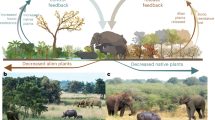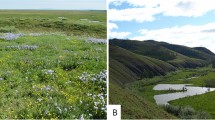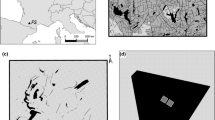Abstract
We used a data set of ungulate censuses from 31 natural ecosystems from East and Southern Africa to test two hypotheses: (1) megaherbivores should dominate ungulate communities in ecosystems with high rainfall and low soil nutrient status because of their ability to survive on poor quality food resources, and (2) the abundance of megaherbivores affects the abundance of the mesoherbivores, distinguishing the different feeding guilds: mesograzers, mesobrowsers and mesomixed feeders. Two axes of a multivariate analysis (77% of the variance) discriminated the sites well, the first separating sites dominated by megaherbivores from those dominated by mesoherbivores, and the second representing a gradient between mesograzers and mesobrowsers. Our analysis shows (1) that megaherbivores can be considered to be a separate trophic guild and (2) that mesograzers and mesobrowsers respond differently to variation in their trophic environments. The metabolic biomass density of megaherbivores increased with annual rainfall, but was not related to soil nutrient status, and as predicted, megaherbivores comprised a larger proportion of the biomass of ungulate communities in ecosystems with high rainfall and low nutrient soils. The metabolic biomass density of mesoherbivores increased with rainfall and soil nutrient status. Within the mesoherbivores, the metabolic biomass density of mesograzers showed the same trend, and seemed unaffected by megaherbivores. Conversely, mesobrowsers and mesomixed feeders appeared to be unaffected by rainfall or soil nutrient status, but mesomixed feeders declined when megaherbivores were abundant. This suggests that megaherbivores may compete with the mesomixed-feeder species for food or they may alter the vegetation communities unfavourably. A similar analysis using elephants alone instead of megaherbivores as a group showed that both mesobrowsers and mesomixed feeders were affected significantly by elephant, which is consistent with the fact that most of the effect of megaherbivores on browse resources or woodland habitat is due to elephants. This study shows that the different trophic guilds within African ungulate communities react differently to environmental factors (rain and soil), and that megaherbivores, and particularly elephants, appear to compete with mesomixed feeders and mesobrowsers. These results are relevant for the understanding of the functioning of African ungulate communities and call for further testing with longitudinal data.
Similar content being viewed by others
Author information
Authors and Affiliations
Corresponding author
Additional information
Electronic Publication
Rights and permissions
About this article
Cite this article
Fritz, H., Duncan, P., Gordon, I.J. et al. Megaherbivores influence trophic guilds structure in African ungulate communities. Oecologia 131, 620–625 (2002). https://doi.org/10.1007/s00442-002-0919-3
Received:
Accepted:
Published:
Issue Date:
DOI: https://doi.org/10.1007/s00442-002-0919-3




